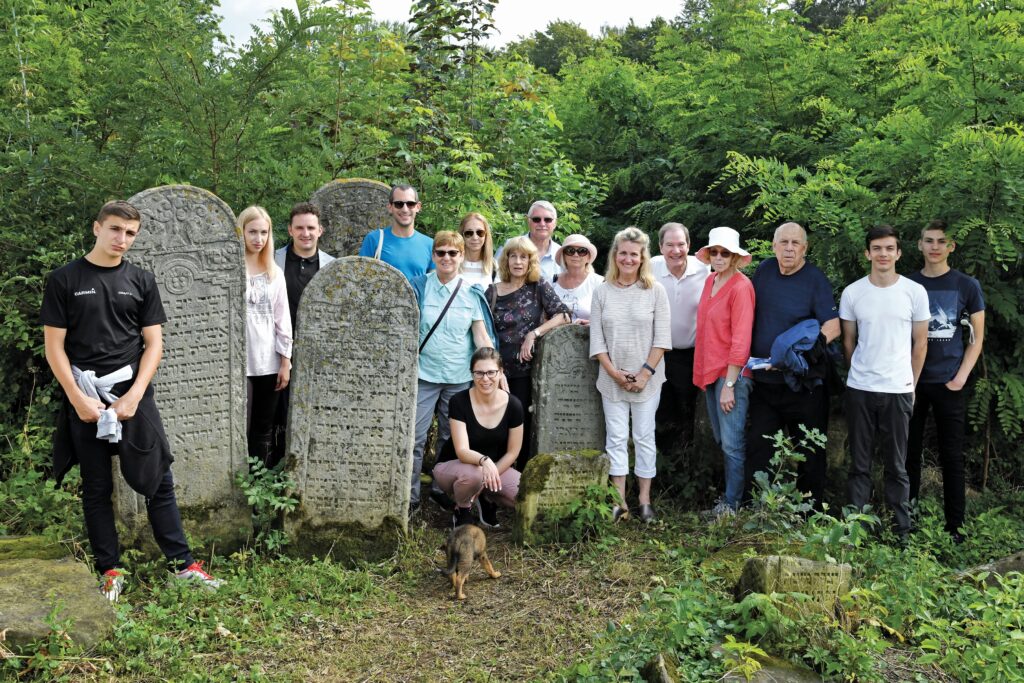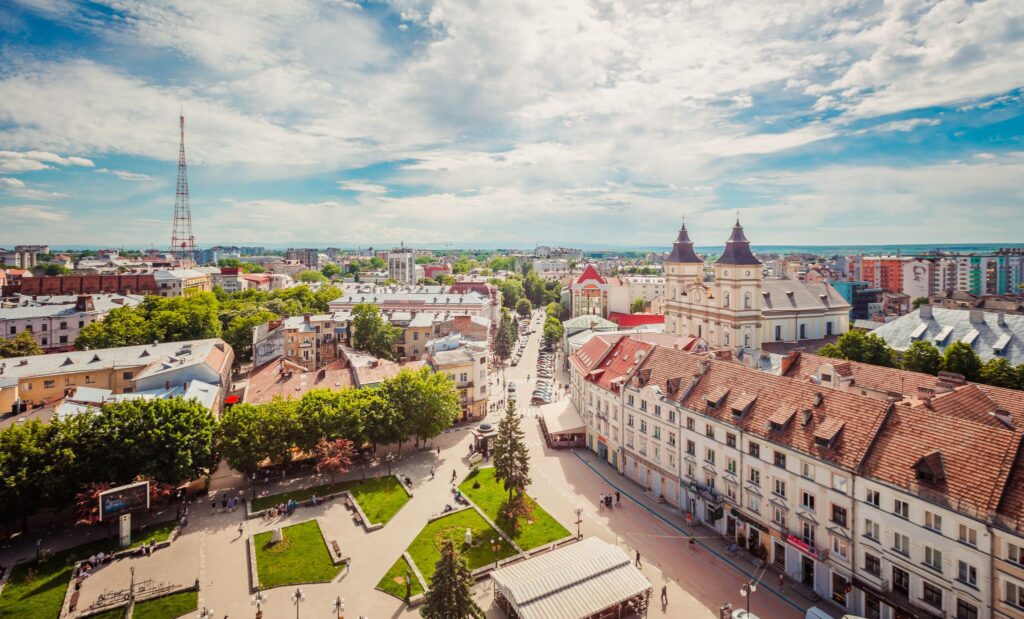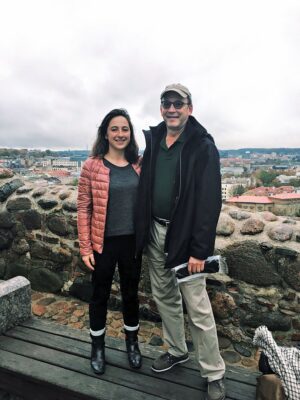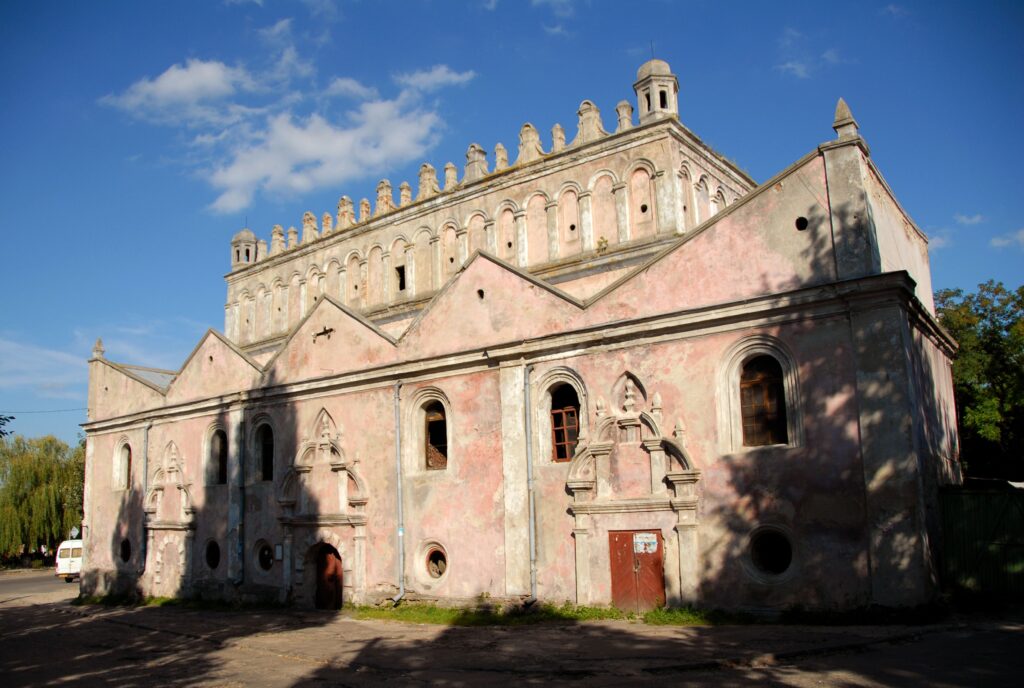The Jewish Traveler
Feature
A Pilgrimage Through Ancestral Lands
Steve Turner, a dentist in Roslyn, N.Y., can only imagine what his father and grandparents would have thought if they’d seen him chant the Shabbat haftarah portion at the family shul. “There I was, standing on the same bimah, in the same synagogue my ancestors used to go to,” marveled Turner.
It was remarkable because the synagogue is in Ivano-Frankivsk, a city in the part of Western Ukraine—once known as Galicia—from which Turner’s father fled during World War I, before resettling in Vienna and, later, New York. Turner returned in 2018 with a group of 15 descendants of Nadworna, the shtetl where his father was born. He met them through Gesher Galicia, the genealogy group of which he is president. In the town now called Nadvirna in Ukraine, each visiting family told its story as they dedicated a monument to local Shoah victims. “It was one of the most emotional moments of my life,” recalled Turner, 68. “I really felt the presence of my father’s family, his sisters who didn’t survive.”

Turner is among a growing number of Jews who, often after years of genealogical research, are visiting their ancestral hometowns in person. So-called roots travel has been around for years. But the explosion of online archives, Facebook genealogy groups and DNA tests confirming genetic ties has galvanized more families to explore their heritage together. Even the pandemic, which halted most international travel, hasn’t stopped would-be travelers from planning voyages that are years in the making.
“When you’re ready, and the time is right, I always tell people that the more homework you do now, the easier it will be for us to create your itinerary,” said Helise Lieberman, who continues to receive a steady flow of emails about the Jewish heritage tours she coordinates as director of the Warsaw-based Taube Center for the Renewal of Jewish Life in Poland. Planning an ancestral pilgrimage, Lieberman added, “is a great thing for families to do together, especially when kids get involved and see how things connect.”
Today’s global travelers are seeking out immersive experiences and personal connections, not only to the past, but also to the modern societies that have evolved since their ancestors departed.
“The biggest surprise for visitors is that life is happening in color here,” observed Tomasz Cebulski, a Krakow-based Holocaust scholar whose company, Polin Travel, customizes Jewish itineraries in Poland. For contemporary Jews raised on black-and-white war footage, “there’s a visual shock seeing modernity, seeing young people, and seeing that most people could not care less about World War II.”
That was certainly the case for Turner, who was taken aback by the affluent feel of the land his ancestors fled in poverty. After flying to Warsaw and before joining the Nadworna group, Turner and his wife hired a private guide and driver to tour Vienna, Budapest and Sedziszow Malopolski, Turner’s mother’s ancestral shtetl in southeast Poland. “I expected to see Anatevka,” said Turner, referring to the bedraggled fictional shtetl in Fiddler on the Roof. “But it was a beautiful, modern little town with nice brick sidewalks.”
Read More: How Genealogy Became the Great Jewish Pastime
Despite a friendly reception throughout Poland and a visibly poorer Ukraine, Turner felt shivers of the not-so-distant past. In Zhovkva, a Ukrainian town near Lviv, Turner’s group was sobered by still visible imprints of mezuzahs on doorways. They heard stories of daring escapes and hidden Jews during a walking tour with the rabbi of Ivano-Frankivsk. And when they finally arrived in Nadworna, they were met by a crowd of villagers, schoolchildren, reporters and even the mayor.
Moved by the enthusiastic engagement of the locals, Turner and his fellow travelers used the trip as a springboard for an ongoing relationship: Along with working together to restore the Jewish cemetery—an ongoing project—they raised several thousand dollars through a GoFundMe page to refurbish the local library.

Turner’s experience illustrates how far genealogy travel has come in the past 20 years. Before DNA kits, social media and English were ubiquitous, it would have been nearly impossible to forge the relationships cemented among those on the Nadworna pilgrimage—not only between descendants and locals, but also between the travelers themselves. One example from his trip: When Lily Bink of Buffalo, N.Y., and Lea Raps of Ramat Gan, in Israel, both expressed interest in the nearby shtetl of Majdan Górny, it led to the discovery that their grandmothers were sisters, which they confirmed after the trip through DNA matching.
“The revolution in genealogy travel is Facebook,” observed Ruth Ellen Gruber, a veteran journalist and Jewish travel authority based in Italy and Budapest. “There are a million Facebook groups, with subgroups for individual cemeteries, synagogues, shtetls and so forth. People can ask questions and get immediate answers from across the world.” Gruber oversees what is arguably the most comprehensive resource for Jewish heritage tourists: the web portal Jewish Heritage Europe, with daily updates on Jewish heritage-related sights, events and people across the continent, along with genealogy and travel insights.
Read More: The Pros and Cons of Consumer Genetic Testing
Caroline Wallis’s experience proves that sometimes the Internet is not enough, and that crossing the world can be necessary. Wallis, a 27-year-old former content manager for the DNA testing company 23andMe, grew up in California with a strong Irish-Polish Catholic identity, even visiting Ireland with her family to explore her mother’s heritage. When she had the opportunity to connect with her father’s Polish roots while studying abroad in 2014, Wallis found an enthusiastic welcome from overseas cousins. They squired her around cafes and cathedrals before sitting her down on the last day of her trip to say: “We’re not actually related. Ask your grandparents why.”
Back in America, Wallis’s father kept mum. But when her paternal grandfather died shortly thereafter, Wallis found the secret in a trove of immigration documents. Her grandfather had been born Weintraub; he and his wife, both Jewish Holocaust survivors, assumed a new Catholic identity when they came to the United States. While Wallis’s grandfather spent the war in a concentration camp, his wife was hidden from the Nazis by a Polish Catholic family—the same “cousins” Wallis would later visit.

In 2017, Wallis traveled back to Poland and Lithuania in search of answers—and with her father, Dr. James Wallis, in tow. Working with a tour guide and a professional genealogist at the Emanuel Ringelblum Jewish Historical Institute in Warsaw, the Wallises traced back their family seven generations and connected with a great uncle in Israel. At the family graves in a cemetery outside Vilnius, “my dad and I were probably the first people in 70 years to pay respects,” Wallis said.
For those planning to combine family research with a group tour—to get an overview of, say, the Jewish heritage of a particular region, or visit concentration camps—specialists often arrange private excursions before or afterward, allowing families to explore smaller towns or visit archives. In addition to lining up local guides, operators can coordinate translators, drivers, genealogists, archivists and—crucially—the man with the key to the cemetery.
“People think they can find all the records online, but that’s often not the case,” said Joseph Benatov, a Jewish cultural scholar who leads heritage tours through his Philadelphia-based company, Sephardic Balkans. Benatov’s guests have spotted long-obscure family names on the deportation memorial at Thessaloniki’s Jewish Museum in Greece or in the vital records registry maintained at the synagogue in Sofia, Bulgaria. “In places like Sofia, the vast majority of documents are not available digitally, so you’re doing detective work on the spot,” explained Benatov, a Sofia native who is planning his own roots journey to Spain. “You need to hire a local specialist who can access and read material from the archives—a highly bureaucratic and specialized job.”
That was true for Joe Youcha of Arlington, Va., who signed up for Benatov’s tour of Bulgaria, North Macedonia and Greece a few years ago without having done much research. Youcha had grown up hearing about how his great-grandfather, a prominent member of the Macedonian Jewish community, sent his 12-year-old son—Youcha’s grandfather, Victor Haim Yakov Youcha—to Tunisia, and later mailed blackberry jam to the homesick young man once he immigrated to New York. Nearly all of Macedonia’s Jews were deported during World War II; Youcha wondered if his great-grandfather, Yakov Ishach, had been among them. “I very consciously decided to let things come to me instead of searching them out,” said Youcha, 58, a boat builder and math instructor for the United Brotherhood of Carpenters, a national union.
Read More: When a DNA Discovery Belongs to the Whole Family
Amazingly, things did come to Youcha. In the capital of Skopje, the Holocaust Museum was closed, but Benatov’s local guide found the curator, who, learning of Youcha’s Macedonian heritage, produced a book that clarified his original family surname—Ishach—and a prewar street address. By the time they got to Bitola, formerly known as Monastir, Youcha’s fellow travelers were cheering on his quest. “My story was unfolding in real time in front of them,” he recalled.

In Bitola, Youcha asked a woman working in her garden about the address he’d found. She ran inside and came out with her husband, who happened to be the national archivist. Even more coincidentally, the archivist had just uploaded a cross-referenced guide to Bitola’s historical street names. Youcha also discovered that his great-grandfather had died of natural causes in 1943 after unsuccessfully trying to resettle his family in Palestine. And Youcha’s grandfather? Turns out, he had been sent away because he had witnessed a murder and was in danger. Together, the details he learned humanized a man Youcha had grown up believing was “kind of a son of a bitch.”
“It’s complicated, how the family stories get passed down and interpreted by the different generations,” reflected Youcha. He bought blackberry jam to bring home for his Ladino-speaking father. At the Bitola cemetery, which dates to 1497, when Iberian-Jewish refugees settled in then-Ottoman lands, the group said an emotional Kaddish for Youcha’s perished relatives.
“I wanted to walk the same streets where my grandfather had walked,” said Youcha. “I felt I had done that. And it was pretty damn powerful.”
Planning the Ultimate Roots Trip
Genealogy travelers can coordinate their own itineraries, join a group heritage trip or hire a specialist to customize a tour—or combine the latter two.
Veteran roots travelers suggest hiring professionals in the destination to assist during the trip, including genealogists; tour guides (typically licensed) who specialize in Jewish heritage; and drivers to navigate out-of-the-way terrain. Local genealogy societies connect visitors with experts to negotiate access to cemeteries, archives and curators. For travelers with roots in Europe, Jewish Heritage Europe is a comprehensive, continuously updated portal for places, events and resources.
Genealogy tour operators perform the legwork, coordinating itineraries and local experts around families’ goals and interests. For Ashkenazi heritage, the best-known outfits include Warsaw-based Taube Jewish Heritage Tours and Krakow-based Polin Travel, which customize tours of what is today Poland; Lublin-based Rootka, which tours Poland, Ukraine and Belarus and is affiliated with Shtetl Routes, a Jewish heritage tourism project; and JUkraine, which highlights personal connections to Ukrainian Jewish communities. In Southeast Europe, Sephardic Balkans works with local experts to personalize tours of Trieste, Croatia, Bosnia, Serbia, Bulgaria, Greece and Romania.
Hilary Danailova writes about travel, culture, politics and lifestyle for numerous publications.
You Won’t Want to Miss: When DNA Reveals Hidden Truths: An Online Event
November 18 at 8:00 PM EDT
Hadassah Magazine Discussion Group presents: How Genealogy Became the Great Jewish Pastime, with Executive Editor Lisa Hostein, featuring Dani Shapiro, Jennifer Mendelsohn and Libby Copeland.










 Facebook
Facebook Instagram
Instagram Twitter
Twitter
Nancy Snyderman Rose says
Thanks for this. I’m trying to find Rajahoof (sp). My grandfather was from there. They said it was in Galicia, Austria. He left in the early 1900’s. Does anyone know anything about Rajahoof. His name was Gershon Alzafrom, in the US, Harry Scop. His mother’s maiden name was Shief(sp). Any information would be great. Thanks, Nancy
Ed Mitukiewicz says
@ Nancy Snyderman Rose :
“Rajahoof” seems to be a phonetic match pointing to the town of Radziechów – known today as Radekhiv in Ukraine [ https://sztetl.org.pl/en/towns/r/961-radekhiv ] and located to the east of the present-day Polish-Ukrainian border. The town of Radziechów appears diagonally down from the top right corner of this 1889 Australian map of pre-WW1 Eastern Galicia: http://lazarus.elte.hu/hun/digkonyv/topo/200e/42-50.jpg
Ed Mitukiewicz says
Erratum: Please read “Australian map” in my previous comment as *Austrian map* the auto-correct function seems to have a mind of its own.
Tomasz Cebulski says
Dear Nancy. The only town I can connect in Galicia to the spelling you have offered is Rzeszow in Yiddish Raysha in German Reichshof . The Allzafrom surname is very unique. I have fund just one record but some 200 km east from Rzeszow in Kamionka Burzanska (nowaydays Ukraine) . There were very many Shief family members in Rzeszow.